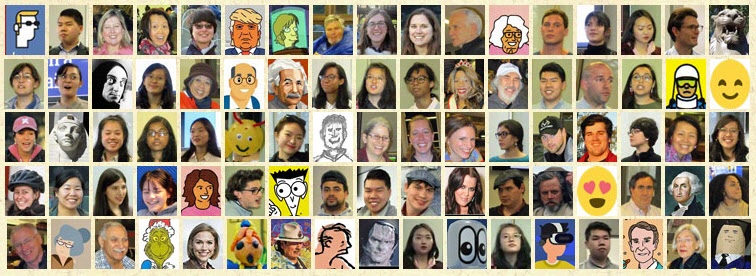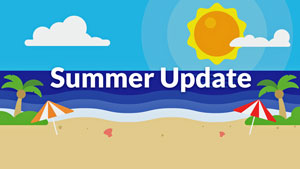
|
Design, Technology , and Engineering benefitting individuals
with disabilities and older adults in the local community |
July 19, 2021 |
|
|
|
|

Perspectives is the newsletter of the
Stanford course,
Perspectives in Assistive Technology.
Summer Update
This newsletter issue summaries last academic year's
course
and describes plans for the coming
year.
|
Perspectives in Assistive
Technology is a Winter Quarter Stanford course - entering its
sixteenth year - that explores the design, development, and use of
assistive technology that benefits people with disabilities and older adults.
It consists of semi-weekly in-person discussions; lectures by
notable professionals, clinicians, and assistive technology users; tours
of a local medical center and an accessible inclusive playground; student
project presentations and demonstrations; and an Assistive Technology
Faire. |
Summer
Update
Greetings, members of the Stanford's Assistive
Technology course community,
I hope you are doing well - getting vaccinated, staying
healthy, and being safe - during this post-pandemic time. Over the past several
months, I have been scrambling to finish my Winter Quarter Assistive Technology
course, including reading final reports and submitting grades. I have continued
to struggle to keep up with my physical exercise, emails, meetings, virtual
conference presentations, and interactions at home with my laptop. My previous
on-campus routine has been disrupted and I have just begun seeing friends and
colleagues in person. However, I am optimistic about the return to "normal
life" at home and at on-campus. Here is my report on what has happened since
the end of March and my thoughts for the future.
Review of last academic
year's course
-
Thanks - First, I would like to thank everybody
who participated in the course as a student, a guest lecturer, an Assistive
Technology Faire vendor, a project partner, or an interested community member.
Your contributions are much appreciated.
-
Students - This past academic year, the course
enrolled 43 students who Zoomed in from their Stanford residences, from their
homes in the US, and from several foreign countries. Twenty-four worked on
projects - some fabricated prototypes, others produced CAD designs, and some
wrote reports on assistive technology products or facilities. One student
contracted the COVID virus but recovered quickly. Here is a
slideshow of their
projects.
-
Student comments - Despite a few glitches with
Zoom and network issues, the course went well. Here are the
students' comments.
Plans for next year's
course
-
In-person instruction - Stanford is planning to
hold in-person instruction starting in the Fall. One important change is the
timing of the class sessions. As you may recall, this course ran from 4:30 to
5:50pm on Tuesdays and Thursdays. This was an ideal time slot as community
members were able to take advantage of open parking after 4:00pm. However, the
new time schedule offered 90-minute class sessions starting at 3:15pm and
5:30pm. I choose the earlier time to take advantage of the daylight and allow
field trips to the VA Medical Center and the Magical Bridge Playground. The
10-minute increase in class time permits a tenth team and its 3 students to
participate in the course.
-
Course activities - Stanford courses are planned
to be taught in-person in the coming academic year, so I will be re-instating
the following course activities and features: team projects, community
attendance in class sessions, field trips, in-person Assistive Technology
Faire, movie night, and most importantly, chocolate chip
cookies.
-
Classroom assignment - Almost every year I have
had trouble securing a suitably accessible classroom. I thought this year would
be no different - or even more difficult due to rennovations and unavailability
of some classrooms. I submitted an email to the folks who assign classrooms to
courses outlining the accessibility needs, DEI (Diversity, Equity, and
Inclusion) implications, and ADA mandate for a reasonable accommodation for
students, guest lecturers, and community members with disabilities or older
adults. I just found out last week that my request was read and the classroom I
used in 2019 and 2020 - Lathrop 282 - has now been assigned to my
course!
-
Course schedule - I plan to follow my course
strategy of inviting guest lecturers to present in class sessions. I do not
anticipate many new presenters. Contacting them, getting their available dates,
and scheduling the class sessions will occur over the next several
months.
Upcoming
solicitations
-
Project and Faire solicitations - In preparation
for the upcoming Winter Quarter course offering, I would like to begin to
solicit projects suggestions from community members now and Assistive
Technology Faire vendors thereafter. Here are some project criteria to
consider:
- Project suggestions must address a real challenge experienced by a
community member with a disability or older adult who lives in the local
community. The problem or struggle must be one that is not adequately served by
existing commercial products. (Perform an internet search to verify this.) It
is important to identify and describe the challenge rather than imagining a
solution.
- The scale of the project must be such that it could be pursued by a
team of three students in the 10-week quarter, resulting in a fabricated
functional prototype.
- Refer to Project
Requirements webpage for further information.
Here is an example project suggestion that should guide
your thinking:
|
Example Project
Suggestion
| Title: |
Improved Pooper Scooper |
| Background: |
The intended user is an older adult who relies on her
powered wheelchair and service dog for mobility. |
| Problem: |
Current products are bulky, difficult to operate, and
are not designed for wheelchair users. |
| Aim: |
Explore designs for a device that will allow a
wheelchair user to effectively clean up after their service dog while remaining
active in their community. |
| Design Criteria: |
Compact to facilitate storage
Aesthetic
design
Easy to retrieve and store
Integrated waste disposal bag
Easy
to dispose bag
Easy to clean |
Examples of reacher products for inspiration:
Examples of pooper scooper products that are too
bulky:
|
Please contact me with your ideas, questions, comments,
and project suggestions - or just to say hello. Please continue to stay safe
& healthy.
Dave Jaffe - Course Instructor
Let me know if you wish to be removed from this
list.
|

To unsubscribe from this newsletter, please email
Dave. |
|



